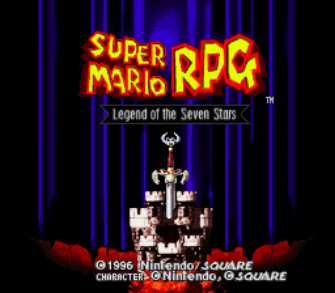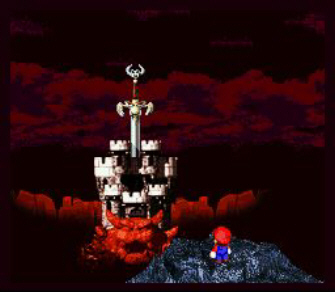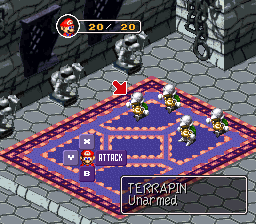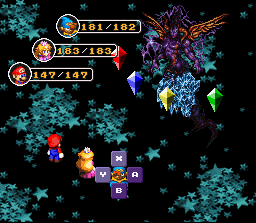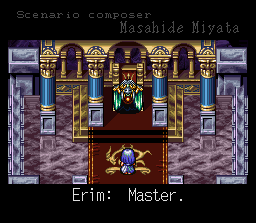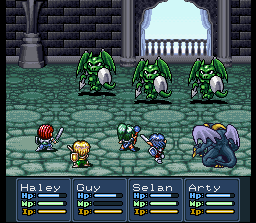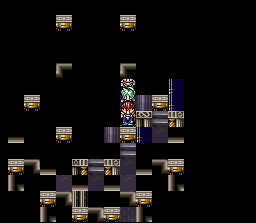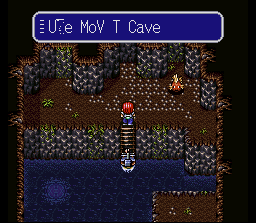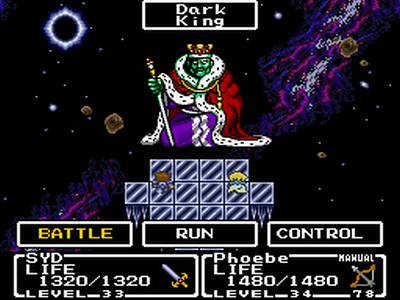
Enchantasy: Quest of the Eternal Grimoire was released in the early 90's for DOS/Windows and one was one of the first games I ever downloaded from the internet, which was shortly after I had played Final Fantasy: Mystic Quest which to note I didn't play for a few years after it's release. Very few people have ever even heard of this game. It was released by EGA Computing and programmed by a single individual who's name I have forgotten . This was one of those independently developed games that was a unique experience but was heavily overshadowed by much bigger titles. The game was released on a simple AOL page that has long since cease to exist. I should state before I start that the computer holding the full version of the game long has since crashed and the only version I have been able to find was the shareware version that was limited to 5 saves and have yet to find a full version (If anyone ever manages to find it let me know). So this RPG talk is based entirely on past experience and the only light refresher I was able to take with the shareware version of the game.
Enchantasy takes place in the world of Savilia. People are disappearing, monsters and evil humans are roaming the land. Eradan, a humble mage apprentice is summoned to the mage guild headquarters and is tasked with finding the Eternal Grimoire, a legendary spellbook that suppose has the power to cease the evil powers threatening the world. With his friends: The warrior, Jared. The ranger, Rodell. And the thief, Shyna. They would have to scale the globe seeking the Grimoire, searching for the kingdom's prince, discover the mysterious assassinations of the guild members, and confronting an evil wizard.
The story as a whole wasn't entirely original even for the time it was developed. However it uses a much older style of progression and story method in comparison to the JRPGs that were more common on the consoles at the time. There is very little character development between the actual main characters and the actual direction is more open world. NPC dialogue requires some probing in order to learn anything useful. Simple one to two word phases could be typed to try to learn more about what an NPC knows. Most of the time this was accomplished by using by typing a word that the person themselves said. Other then seeking out the four characters the rest of the game is pretty much self directed by what you yourself learn from the surrounding world and the people living in it. The only limits set are the strength of the monsters that you fight. The gameplay is actually more similar to D&D or other earlier RPG games where the story is more directed by the player though there is an eventual endpoint.

The game play is very, very aged. The entire game game play consists mostly of single keyboard commands and the player is capable of moving in only four directions. Many options require additional skill or input such as Invoke or Pick commands. There aren't very many puzzles in most places and requires more exploration or the use of the Invoke command to activate certain areas. In general you have to figure out when and where to go to places because the dungeons themselves give few clues of what your suppose to be doing there. So often times I could recall myself taking down notes to keep track of the things I needed to do or where I needed to go. As tedious as that sounds it did keep you moving forward because you had to pay attention if you wanted to know what was going on. The story really isn't spoon-fed to the player.
Gear was kept fairly simple, weapons, shields, armor were pretty standard to the specific characters but the items were just expensive enough that it did take some work to keep your characters gear up. Also all gear was skill-based in other words if you were too low in level for the gear, you couldn't use it. Skills and abilities did fall back on some old style RPG style type play, as you leveled you received training passes to train in skills such as first aid, magic, range, melee, lock picking, etc rather then simply learning them as you leveled. And since you only earned one pass per experience level it would require you to think through what it was you needed to do. In addition, there is a food supply stat that requires you to purchase food which did place a slight time restraint on how long you could stay away from town. Allowing food to drop to zero would cause a Hunger status that would do a poison like damage over time.
Battles had a mix of random encounter and encounter based in specialized places (you still couldn't see the enemy but running away from these enemies would force your character to step back, so until you won you can't move forward). Battles took place on a large, grind like placement similar to some tactic RPGs. Characters could moving in any of the eight directions and attack any target in eight directions. Bows, Slings, and Magic could allow you to hit enemies from distances, but you couldn't shoot anything next to you, though you could still use magic. But because the characters can only move one space, it really forced you to plan your move carefully or you might end up surrounded. Experience works very differently. Unlike most RPGs at the time, the amount of experience a character earned at the end of a fight entirely depended on their use in battle. If you stand back and let your mage wipe everything out with spells, none of your other characters will gain any experience as a result. Experience was also lost when you ran away. The only problem with this is that it heavily penalized your ability to conserve your resources for tougher fights and particular in areas with high encounter rates could leave you losing quite a bit of exp when you're weaken. The quests you can complete allow you to earn higher numbers of experience in burst which does soften the blow slightly.
I will say this straight out, this game is HARD. Unlike most RPG console games I was playing at the time, the battles were extremely difficult, and taking the quickest and easiest way out could end up hurting you very quickly and punished you heavily for mistakes. Experience accumulates rather slowly so additional grinding for the sake of trying to build up what you need. Some areas had battles ranges that would go from a cakewalk to a impossible death match at a moments notice. The rest of the difficult was based on fact it was extremely difficult to figure out where you were suppose to go and when you should go. It's wasn't always obvious how strong the monsters would be from one area to the other and since there were very few things preventing you from entering most area, and it was easy to enter a place early on with monsters many times greater then you can handle.
The graphics are old even in the 80's they were aged. The graphics use EGA style graphics that were more common in the earlier days of computer games. NPCs and characters hardly ever move. There are probably about 2 frames of animation for water. Battle sprites look little like what they are suppose to. Attack animations pretty much consist of two frames one swing left or right then swing in the other direction. To be expected there is a lot of palette swapping and the environments are limited. The area design though is fairly solid, many of the castles and towns are actually arranged like actual places and don't tend to look identical which does leave an impression regardless of the lack of detail.
The game has no music and very few sound effects, giving the detail to graphics this isn't very surprising, the game using some authentic sounding sound effects, though at a low bittage. The battle start and end have short jiggles.
The game being what it is doesn't appear to have a lot of exploitable glitches. Though there was a cheat code that was coded right into the game that would allow you to heal, get full items, and so on. You could alter a lot of things with a hex editor if you knew what you were looking for.
There weren't a ton of extras, there were certain quests that you could do. Some were required while others were not. More then anything the point of these quests were to gain experience and sometimes items that were sometimes needed. While other times when they weren't needed at all.
How does Enchantasy hold up? We due to it's lack of acknowledgment it's obvious the game didn't leave much impact which was the fate of many independently developed games. As an RPG, Enchantasy was a solid experience. It had a very large world to explore and many things to accomplish. The graphics and sound were very subpar which probably threw some people off. If you are able to look past it though it's technological shortcomings , Enchantasy: Quest for the Eternal Grimoire is worth a try...
...
...
If you can find it that is.
